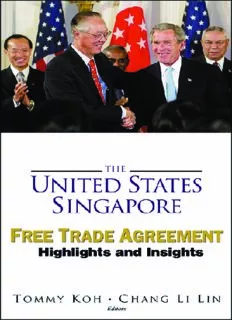
The United States: Singapore Free Trade Agreement Highlights and Insights PDF
Preview The United States: Singapore Free Trade Agreement Highlights and Insights
THE UNITEDSTATES SINGAPORE FREE TRADE AGREEMENT HIGHLIGHTS AND iNSIGHTS THE U S NITED TATES S INGAPORE FREE TRADE AGREEMENT Highlights and Insights edited by TOMMY KOH CHANG LI LIN This page intentionally left blank Published by Institute of Policy Studies 29 Heng Mui Keng Terrace Singapore 119620 and World Scientific Publishing Co. Pte. Ltd. 5 Toh Tuck Link, Singapore 596224 USA office: Suite 202, 1060 Main Street, River Edge, NJ 07661 UK office: 57 Shelton Street, Covent Garden, London WC2H 9HE British Library Cataloguing-in-Publication Data A catalogue record for this book is available from the British Library. Photo on the cover: From left to right George Yeo, Minister for Trade and Industry, Singapore; Goh Chok Tong, Prime Minister of Singapore; S. Jayakumar, Minister for Foreign Affairs and for Law, Singapore; George W. Bush, President of the United States of America; and Colin L. Powell, U.S. Secretary of State. Source: Reuters THE UNITED STATES-SINGAPORE FREE TRADE AGREEMENT: HIGHLIGHTS AND INSIGHTS Copyright © 2004 Institute of Policy Studies, Singapore and World Scientific Publishing Co. Pte. Ltd. All rights reserved. This book, or parts thereof, may not be reproduced in any form or by any means, electronic or mechanical, including photocopying, recording or any information storage and retrieval system now known or to be invented, without written permission from the Publisher. For photocopying of material in this volume, please pay a copying fee through the Copyright Clearance Center, Inc., 222 Rosewood Drive, Danvers, MA 01923, USA. In this case permission to photocopy is not required from the publisher. ISBN 981-238-848-6 Inhouse Editor: Juliet L C Lee Printed in Singapore. Section 0 Foreword USSFTA_foreword.p65 5 19/03/04, 9:57 AM This page intentionally left blank Every free trade negotiation has its unique history. The United States-Singapore Free Trade Agreement (USSFTA) was conceived one dark stormy night in Brunei after a round of night golf between Prime Minister Goh and President Clinton. Then USTR Charlene Barshefsky played a critical role in making this happen. It was one of the final acts of the Clinton Administration. When George W. Bush became President two months later, he and USTR Bob Zoellick were fully committed to the early conclusion of the negotiations. Ambassador Zoellick reminded me that years earlier, when he was Undersecretary to Secretary of State James Baker, he had proposed an FTA with us but we were then not prepared to open up some of our services sectors. Apart from the benefits of increased trade and investment in goods and services, both sides wanted the agreement for strategic reasons. For the U.S., a good agreement establishes a template for future free trade agreements with other countries particularly in the area of intellectual property. It also signals the U.S.’s long-term commitment to Asia. For Singapore, the Free Trade Agreement strengthens us as a hub for manufacturing and services. We also knew that it was the first step towards a closer relationship between ASEAN and U.S., which is of strategic importance not only to Singapore but to all of Southeast Asia. The Agreement is therefore an important bridge across the Pacific built at the right place and at the right time. So many people on both sides took part in its construction. As was to be expected, there were many problems to be solved along the way. In the end, we were able to build in less than two years a structure which is solid and elegant, and already serving the purposes for which it was intended. I thank IPS and SBF for compiling this record. George YEO Minister for Trade and Industry, Singapore February 2004 vii USSFTA_foreword.p65 7 19/03/04, 9:57 AM January 2004 is indeed a historical moment as the United States- Singapore Free Trade Agreement (USSFTA), the first ever agreement between the U.S. and an Asian-Pacific country has been implemented. It has been a long but patient wait of three years since the announcement by the leaders of the two countries to launch the USSFTA back in November 2000. We have finally reached this stage, when the agreement has finally become law where businesses will be able to benefit from it. The past few years had been most difficult: gloomy global economic situation; terrorist attacks; Severe Acute Respiratory Syndrome (SARS); and bird flu outbreak had all affected businesses worldwide. However, there are some signs that we are heading towards a recovery. The U.S., the world’s largest economy, is showing evidence of recovery: manufacturing and property markets are picking up, and the improvement in employment and consump- tion also point to an improving economic performance in 2004. Thus the implementation of the U.S.-Singapore trade pact comes at the most appropriate time. Besides, enabling improved market access and tariff savings for Singapore’s exports to the U.S., the agreement will help generate better-paying jobs and opportunities for businesses and people, both in Singapore and in the United States. I must appraise the great work done by the Singapore negotiation team, led by our Ambassador-at-Large Professor Tommy Koh. Under his guidance, the team comprising senior government officials and subject experts had worked hard for the past three years with many rounds of negotiation to reach an agreement with their U.S. counterparts. On behalf of all businesses in Singapore, I would like to express our sincere appreciation to every single member of the team. It interested me when Professor Koh told me about writing this book, with the idea of sharing the insights they faced throughout the viii USSFTA_foreword.p65 8 19/03/04, 9:57 AM Foreword ix negotiation process. I am glad to listen to some light-hearted stories from Professor Koh himself, amidst the hard work of negotiation. As his books usually are, I find this book very enjoyable, and I believe you would share my sentiments after reading it. Stephen LEE Chairman Singapore Business Federation USSFTA_foreword.p65 9 19/03/04, 9:57 AM
Description: